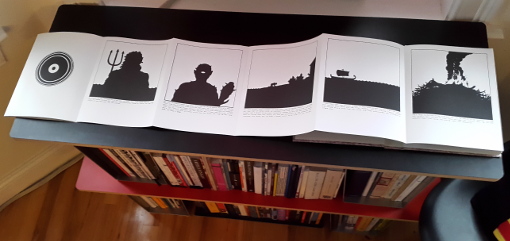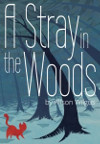Anders Nilsen’s
latest Drawn & Quarterly publication is a formidable follow-up to Big Questions. The accordion book holds the human stories of forgotten (and current) gods, told in text and striking silhouettes.
xkcd’s Answer to World Clock
 … is today’s comic.
… is today’s comic.
And it’s true, Randall probably did not know about _World Clock_ (book, code). Maybe he didn’t even know about my inspirations, Harry Mathews’s “The Chronogram for 1998” or Stanislaw Lem’s _One Human Minute._
In that case it’s an unwitting answer.
In any case, it’s a nice one.
A Stray in the Woods
Here’s an intriguing feline adventure, pleasingly illustrated and narrated. This brings a lot together: It’s the Kickstarter-funded book version of a Web comic in which readers were asked to provide interactive-fiction- or tabletop-RPG-style commands for each situation; the one readers voted up was then chosen and the story proceeded from there. Perhaps I’ve been primed for this, but I thought the book’s presenation of this rather elaborate process was effective. I thought at first that page numbers would help, but perhaps these might have suggested a CYOA-style book, which this is not. While decisionmaking by mob is not always best, and can rule out nuanced plans, it works well enough in this case. And while the freely-available Web version of the story is good, the print presentation also sets the illustrations well. The text narration is consistently set on the recto, with commands below. Other IF transcripts (or the like) could be treated this way, too …
Big Questions
Radical Books of 2011, 10/10
Big Questions, Anders Nilsen, Drawn & Quarterly, 9781770460478
Anders Nilsen has done exquisite sequential art, a.k.a. comix. I’m particularly fond of the trembling outlines and barely-representational figures in The End. The trade book of Big Questions is more conventional in style, but it binds 658 pages and 15 volumes of Nilsen’s work together in an extended, amazing story. In it, birds speak, but aren’t very smart. They devise their own ideas about a piece of unexploded ordnance, for instance, imagining it as an egg. An elderly woman dies in a plane crash; the idiot man-boy she has been caring for survives, as does the pilot. He also doesn’t seem too smart. The drawing style, which passes for simple at times but is nicely composed and filled with rich details, keys into the story, an animal tale that passes beyond childish simplicity. There are none of the mainstream superheros and no hint of the indie comics memoir in these ten years of work by a master of this art. Comic readers should love it; radical readers who wish to try out comics should try it.
Eden
Yes, these comics sometimes veer into the extremely sappy, but they’re metafictional and wonderfully fabular throughout. Eden collects more than 100 simple four-panel strips featuring a diminutive, somewhat rabbit-like king, or at least, someone who wears a crown, in a magical land. An extremely insightful naïvite, of the sort that one hears in the occasional oracular pronunciation of a child, comes through at times. But these comics do not overlook death or other serious subjects. Holmberg, who writes and draws in Buenos Aires, has Eden and more available on his website, in Spanish. Odd that to learn about a Web comic, I had to go into my local comic store and buying a book, but it goes to show that book-based institutions have more than a retail function. And, it seems unlikely that Holmberg’s work would have appeared in translation without a publisher such as Drawn & Quarterly. Through such everyday efforts, we sometimes find the extraordinary.
Comics Are Great when Your Life Sucks
Comics are written by people whose lives suck, for people whose lives suck. Obviously, that’s not entirely true. Alternative comics do seem to be highly in touch with the lameness of life, though, whether they’re chronicling lynchings in the American South, exploring the emotional suffering of outcasts, or taking us through people’s decisions and indecision.
Since this blog is about digital media sorts of things as well as “other stuff [I] like,” I thought I’d note and briefly comment on a few graphic novels that I’ve read recently, even if nothing here feeds directly into computer conversations.
At Henry Jenkins’s recommendation, I read volume one of Jeremy Love’s Bayou, a comic about a girl whose father is a sharecropper and who faces a series of violent and historically apt horrors. This comic, in color, blends in a dreamworld of fabular elements to interesting effect, although the “truth” side of the story ends up being more terrifying and compelling than the “fiction.” For this reason, I think I enjoyed and learned from Mat Johnson and Warren Pleece’s Incognegro even more. This black-and-white comic tells of a black reporter who can pass as white and who goes to the South to document lynchings. Both comics show the strength of family ties and feature a sheriff who is, compared to the lynch mob, a somewhat good guy. Bayou‘s play with fantasy and folklore is nice, but I think Incognegro does even better, incorporating an incredible plot twist and keeping the action within a historical world.
The most dark, bitter, depressing, and hopeless sequential thing I’ve seen recently was Josh Simmons’s House. Three people meet up and explore a huge dilapidated ruin of a house. Guess what happens. Yep, except it’s even worse than you imagine.
I liked Night Fisher by R. Kikuo Johnson a lot. It’s the story of a high school student in Hawaii, a good student who ends up getting involved with drugs and then with despairing criminals for what seems like no particular reason – there’s not much else to do, though. Miss Lasko-Gross has a more amusing tale of school days in Escape from “Special,” which chronicles a younger student’s educational, social, and religious difficulties.
I really liked Dupuy and Berberian’s Maybe Later, a collaboratively written and drawn journal of the duo’s experiences writing and drawing Mr. Jean comics. I’m now reading some of those comics, translated and collected as Get a Life. Dupuy and Berberian don’t divide up the writing and drawing, but actually collaborate at each stage of the comic-creation process, from conception through to execution, much as I’ve collaborated as a writer with Scott Rettberg (Implementation) and William Gillespie (2002, The Ed Report).
Finally, David Mazzucchello’s Asterios Polyp is brilliant, with incredible writing and art. It’s well worth the price and the effort of carrying the hefty book home. The book’s form recalls that of an architecture book and is perfectly apt for this tale of a architecture professor who is a jerk, flawed, and incomplete – who loses the most important thing in his life, loses everything else, and decides to live, to listen and watch life, and to keep searching.
Web Comics Touched by the Brush
The Moon Fell on Me is an infrequent, gemlike Web comic by the itinerant Franklin Einspruch, who happened to come to my recent interactive fiction talk at AXIOM. He told me he was trying to do something different with this Web project. Visit his site even briefly and you’ll see that he has done it. No pen was used in the creation of this Web comic. The panels are not organized to lead toward jokes. The lines of images are clearly based on personal experience, but they reach out beyond an individual or subculture. Instead of the occasionally hilarious, forward-a-link, forget-in-moment frames of the typical Web comic – however incisive that comic might be about geeks or life or both – The Moon Fell on Me offers sequential art that is worth looking at again and again, that resonates with its moment and seems worth contemplating beyond it.





